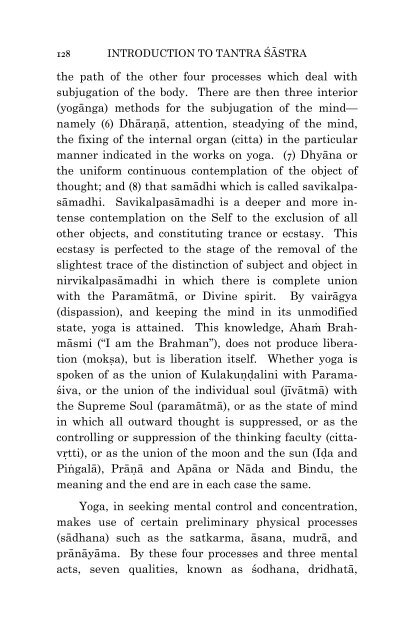Introduction to Tantra Sastra - Aghori
Introduction to Tantra Sastra - Aghori
Introduction to Tantra Sastra - Aghori
You also want an ePaper? Increase the reach of your titles
YUMPU automatically turns print PDFs into web optimized ePapers that Google loves.
128<br />
INTRODUCTION TO TANTRA ŚĀSTRA<br />
the path of the other four processes which deal with<br />
subjugation of the body. There are then three interior<br />
(yogānga) methods for the subjugation of the mind—<br />
namely (6) Dhāraṇ ā, attention, steadying of the mind,<br />
the fixing of the internal organ (citta) in the particular<br />
manner indicated in the works on yoga. (7) Dhyāna or<br />
the uniform continuous contemplation of the object of<br />
thought; and (8) that samādhi which is called savikalpasāmadhi.<br />
Savikalpasāmadhi is a deeper and more intense<br />
contemplation on the Self <strong>to</strong> the exclusion of all<br />
other objects, and constituting trance or ecstasy. This<br />
ecstasy is perfected <strong>to</strong> the stage of the removal of the<br />
slightest trace of the distinction of subject and object in<br />
nirvikalpasāmadhi in which there is complete union<br />
with the Paramātmā, or Divine spirit. By vairāgya<br />
(dispassion), and keeping the mind in its unmodified<br />
state, yoga is attained. This knowledge, Ahaṃ Brahmāsmi<br />
(“I am the Brahman”), does not produce liberation<br />
(mokṣa), but is liberation itself. Whether yoga is<br />
spoken of as the union of Kulakuṇ ḍ alini with Paramaśiva,<br />
or the union of the individual soul (jīvātmā) with<br />
the Supreme Soul (paramātmā), or as the state of mind<br />
in which all outward thought is suppressed, or as the<br />
controlling or suppression of the thinking faculty (cittavṛ<br />
tti), or as the union of the moon and the sun (Iḍ a and<br />
Piṇgalā), Prāṇ ā and Apāna or Nāda and Bindu, the<br />
meaning and the end are in each case the same.<br />
Yoga, in seeking mental control and concentration,<br />
makes use of certain preliminary physical processes<br />
(sādhana) such as the satkarma, āsana, mudrā, and<br />
prānāyāma. By these four processes and three mental<br />
acts, seven qualities, known as śodhana, dridhatā,

















